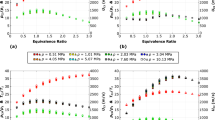We have measured the shape of the luminous zone in a laminar jet diffusion flame burning methane, ethylene, and propane in quiescent air in the pressure range 0.02-0.1 MPa. Soot emission by the flame was not permitted. The flame became more slender and luminous as the pressure increased. At relatively high fuel flow rates, the ethylene and propane flame heights increased with pressure. At low fuel flow rate, the flame height decreased as pressure increased for all three fuels. At high fuel flow rate, the methane flame height first decreased and then increased with pressure, due to the low tendency of methane to form soot. Finally, we observed a tendency toward decreasing – increasing – decreasing flame height at certain fuel flow rates and in certain pressure ranges.






Similar content being viewed by others
References
E. M. Amin, R. A. Yetter, G. E. Andrews, M. Pourkashnian, and A. Williams, “A computational study of pressure effects on pollutant generation in gas turbine combustors,” Journal of Engineering for Gas Turbines and Power, 119, No. 1, 76–83 (1997).
Ahmet E. Karatas and Omer L. Gulder, “Soot formation in high pressure laminar diffusion flames,” Progress in Energy and Combustion Science, 38, 818–845 (2012).
S. P. Burke and T. E. W. Schumann, “Diffusion flames,” Industrial and Engineering Chemistry, 20, No. 10, 998–1004 (1928).
J. R. Camacho and Ahsan R. Choudhuri, “Shapes of elliptic methane laminar jet diffusion flames,” Journal of Engineering for Gas Turbines and Power, 128, 1–7 (2006).
Paul M. Mandatori and Omer L. Gulder, “Soot formation in laminar ethane diffusion flames at pressures from 0.2 to 3.3 MPa,” Proceedings of the Combustion Institute, 33, 577–584 (2011).
G. Intasopa, “Soot measurements in high-pressure diffusion flames of gaseous and liquid fuels,” Ph.D. thesis, University of Toronto, Toronto (2011).
K. A. Thomson, O. L. Gulder, E. J. Weckman, R. A. Fraser, G. J. Smallwood, and D. R. Snelling, “Soot concentration and temperature measurements in co-annular, nonpremixed CH4/air laminar flames at pressures up to 4 MPa,” Combustion and Flame, 140, 222–232 (2005).
H. G. Darabkhani, J. Bassi, H. W. Huang, and Y. Zhang, “Fuel effects on diffusion flames at elevated pressures,” Fuel, 88, No. 2, pp. 264–271 (2009).
Jean-Michel Most, Philippe Mandin, Jie Chen, Pierre Joulain, Daniel Durox, and A. Carlos Fernande-Pello, “Influence of gravity and pressure on pool fire-type diffusion flames,” Symposium (International) on Combustion, 26, No. 1, 1311–1317 (1996).
Manjiang Yang, Y. He, Haihang Li, Xiaocui Zhang, Zhenhua Li, and Jian Wang, , “Combustion of laminar non-premixed acetylene jet at two different altitudes,” Combustion Science and Technology, 184, 1950–1969 (2012).
F. G. Roper, “The prediction of laminar jet diffusion flame sizes: Part I. Theoretical model,” Combustion and Flame, 29, 219–226 (1977).
Wei Yao, Jianping Zhang, Ali Nadjai, Tarek Beji, and Michael A. Delichatsios, “A global soot model developed for fires: Validation in laminar flames and application in turbulent pool fires,” Fire Safety Journal, 46, No. 7, 371–387 (2011).
W. Yao, Jianping Zhang, Ali Nadjai, Tarek Beji, and Michael Delichatsios, “Development and validation of a global soot model in turbulent jet flames,” Combustion Science and Technology, 184, No. 5, 717–733 (2012).
K. T. Walsh, M. B. Long, M. A. Tanoff, and M. D. Smooke, “Experimental and computational study of CH, CH*, and OH* in an axisymmetric laminar diffusion flame,” Proceedings of the Combustion Institute, 27, 615–623 (1998).
C. Aalburg, F. J. Diez, G. M. Faeth, P. B. Sunderland, D. L. Urban, and Z-G. Yuan, “Shapes of nonbuoyant round hydrocarbon-fueled laminar-jet diffusion flames in still air,” Combustion and Flame, 142, 1–16 (2005).
Ahmet E. Karatas and Omer L. Gulder, , “Soot formation in high pressure laminar diffusion flames,” Progress in Energy and Combustion Science, 38, 818–845 (2012).
H. N. Powell, “The height of diffusion flames and the relative importance of mixing and reaction rates,” Symposium (International) on Combustion, 5, No. 1, 290–302 (1955).
Irvin M. Miller and Howard G. Maahs, “High-pressure flame system for pollution studies with results for methane-air diffusion flames,” Technical Report NASA TN D-8407 (1977).
N. O. Umesi, R. P. Danner, and T. E. Daubert, Diffusivity. Technical Data Book – Petroleum Refining. 6th Edition, American Petroleum Institute, Washington (1997).
L. L. McCrain and W. L. Roberts, “Measurements of the soot volume field in laminar diffusion flames at elevated pressures,” Combustion and Flame, 140, Nos. 1–2, 60–69 (2005).
Hyun I. Joo and Omer L. Gulder, “Soot formation and temperature field structure in co-flow laminar methane-air diffusion flames at pressures from 10 to 60 atm,” Proceedings of the Combustion Institute, 32, 769–775 (2009).
Decio S. Bento, Kevin A. Thomson, and Omer L. Gulder, “Soot formation and temperature field structure in laminar propane-air diffusion flames at elevated pressures,” Combustion and Flame, 145, 765–778 (2006).
This research was done with the financial support of the Key Program of the National Natural Science Foundation of China (No. 51036007).
Author information
Authors and Affiliations
Corresponding author
Additional information
Translated from Khimiya i Tekhnologiya Topliv i Masel, No. 4, pp. 33 – 37, July – August, 2015.
Rights and permissions
About this article
Cite this article
Li, H., Zhou, Z., Niu, Y. et al. Effect of Pressure and Type of Fuel on Laminar Diffusion Flame Height at Subatmospheric Pressures. Chem Technol Fuels Oils 51, 389–396 (2015). https://doi.org/10.1007/s10553-015-0616-7
Published:
Issue Date:
DOI: https://doi.org/10.1007/s10553-015-0616-7




